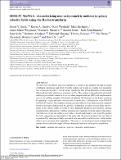Files in this item
SDSS IV MaNGA : characterizing non-axisymmetric motions in galaxy velocity fields using the Radon transform
Item metadata
| dc.contributor.author | Stark, David V. | |
| dc.contributor.author | Bundy, Kevin A. | |
| dc.contributor.author | Westfall, Kyle | |
| dc.contributor.author | Bershady, Matt | |
| dc.contributor.author | Weijmans, Anne-Marie | |
| dc.contributor.author | Masters, Karen L. | |
| dc.contributor.author | Kruk, Sandor | |
| dc.contributor.author | Brinchmann, Jarle | |
| dc.contributor.author | Soler, Juan | |
| dc.contributor.author | Abraham, Roberto | |
| dc.contributor.author | Cheung, Edmond | |
| dc.contributor.author | Bizyaev, Dmitry | |
| dc.contributor.author | Drory, Niv | |
| dc.contributor.author | Roman Lopes, Alexandre | |
| dc.contributor.author | Law, David R. | |
| dc.date.accessioned | 2018-08-13T09:30:10Z | |
| dc.date.available | 2018-08-13T09:30:10Z | |
| dc.date.issued | 2018-10-21 | |
| dc.identifier | 255261705 | |
| dc.identifier | a8c70fdf-d8fe-45fa-b608-52d602ab1783 | |
| dc.identifier | 85054723456 | |
| dc.identifier | 000449614800062 | |
| dc.identifier.citation | Stark , D V , Bundy , K A , Westfall , K , Bershady , M , Weijmans , A-M , Masters , K L , Kruk , S , Brinchmann , J , Soler , J , Abraham , R , Cheung , E , Bizyaev , D , Drory , N , Roman Lopes , A & Law , D R 2018 , ' SDSS IV MaNGA : characterizing non-axisymmetric motions in galaxy velocity fields using the Radon transform ' , Monthly Notices of the Royal Astronomical Society , vol. 480 , no. 2 , pp. 2217-2235 . https://doi.org/10.1093/mnras/sty1991 | en |
| dc.identifier.issn | 0035-8711 | |
| dc.identifier.other | BibCode: 2018MNRAS.tmp.1904S | |
| dc.identifier.other | ORCID: /0000-0002-5908-6852/work/47531783 | |
| dc.identifier.uri | https://hdl.handle.net/10023/15811 | |
| dc.description | Funding: Leverhulme Trust Early Career Fellowship (AW). | en |
| dc.description.abstract | We show how the Radon transform (defined as a series of line integrals through an image at different orientations and offsets from the origin) can be used as a simple, non-parametric tool to characterize galaxy velocity fields, specifically their global kinematic position angles (PAk) and any radial variation or asymmetry in PAk. This method is fast and easily automated, making it particularly beneficial in an era where integral field unit (IFU) and interferometric surveys are yielding samples of thousands of galaxies. We demonstrate the Radon transform by applying it to gas and stellar velocity fields from the first ∼2800 galaxies of the SDSS-IV MaNGA IFU survey. We separately classify gas and stellar velocity fields into five categories based on the shape of their radial PAk profiles. At least half of stellar velocity fields and two-thirds of gas velocity fields are found to show detectable deviations from uniform coplanar circular motion, although most of these variations are symmetric about the centre of the galaxy. The behaviour of gas and stellar velocity fields is largely independent, even when PAk profiles for both components are measured over the same radii. We present evidence that one class of symmetric PAk variations is likely associated with bars and/or oval distortions, while another class is more consistent with warped discs. This analysis sets the stage for more in-depth future studies which explore the origin of diverse kinematic behaviour in the galaxy population. | |
| dc.format.extent | 5963522 | |
| dc.language.iso | eng | |
| dc.relation.ispartof | Monthly Notices of the Royal Astronomical Society | en |
| dc.subject | Methods: data analysis | en |
| dc.subject | Galaxies: kinematics and dynamics | en |
| dc.subject | QB Astronomy | en |
| dc.subject | QC Physics | en |
| dc.subject | DAS | en |
| dc.subject.lcc | QB | en |
| dc.subject.lcc | QC | en |
| dc.title | SDSS IV MaNGA : characterizing non-axisymmetric motions in galaxy velocity fields using the Radon transform | en |
| dc.type | Journal article | en |
| dc.contributor.sponsor | The Leverhulme Trust | en |
| dc.contributor.institution | University of St Andrews. School of Physics and Astronomy | en |
| dc.identifier.doi | https://doi.org/10.1093/mnras/sty1991 | |
| dc.description.status | Peer reviewed | en |
| dc.identifier.url | http://adsabs.harvard.edu/abs/2018MNRAS.tmp.1904S | en |
| dc.identifier.grantnumber | ECF-2014-767 | en |
This item appears in the following Collection(s)
Items in the St Andrews Research Repository are protected by copyright, with all rights reserved, unless otherwise indicated.

